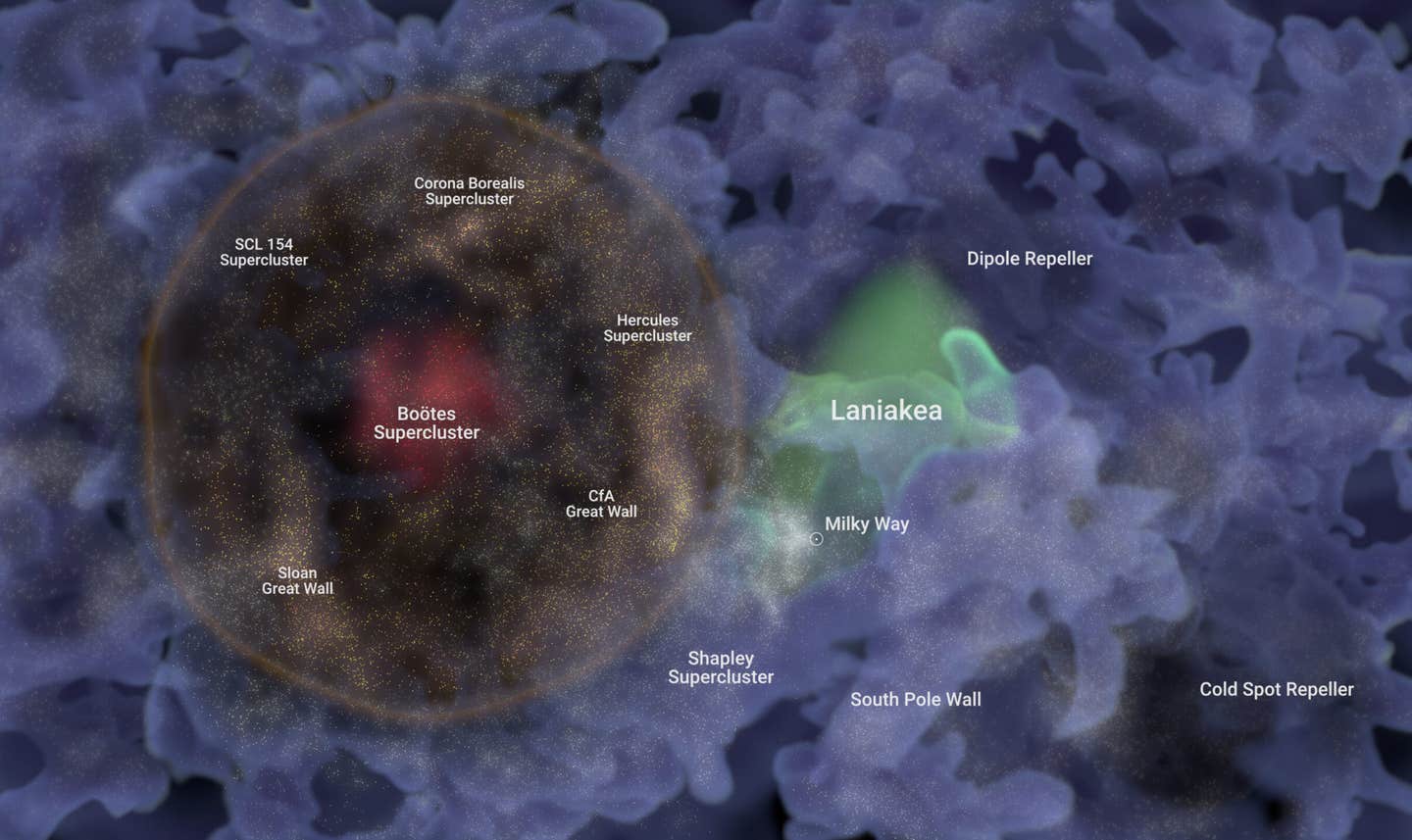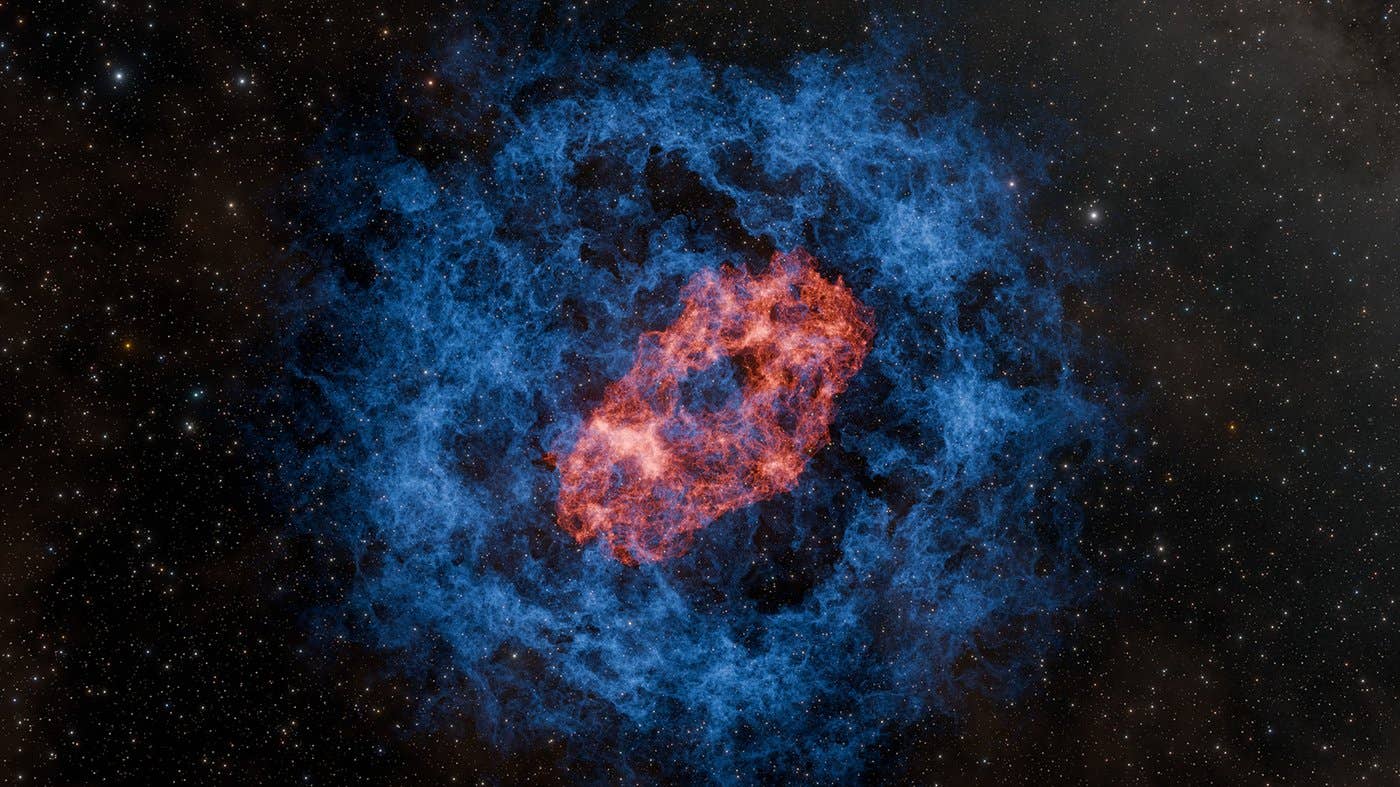Gigantic ‘Bubble of Galaxies’ found stretching across billions of light years
Laniākea—the vast galactic supercluster we call home—could be just one region within a much larger cosmic structure spanning 10x its volume.

The blue filaments show the greater Cosmic Web, with Laniākea highlighted. (CREDIT: Frédéric Durillon, Animea Studio; Daniel Pomarède, IRFU, CEA University Paris-Saclay)
The universe remains a puzzle, full of shifting clues and unexpected revelations. In a new twist, scientists studying galaxy movements have uncovered signs that our cosmic neighborhood might be part of something far larger than we imagined.
By tracing how galaxies drift through space, a research team from the University of Hawaiʻi Institute for Astronomy noticed surprising patterns. These movements suggest that the region containing our galaxy may stretch much farther than previously believed.
More than 56,000 galaxies were analyzed by the Cosmicflows group, an international team of astronomers. Their careful tracking revealed evidence that the basin of space we occupy could be just one part of a much bigger system.
This galactic basin, known as Laniākea, was thought to span about 500 million light-years. But new data points to a structure nearly ten times that size, possibly centered near a region called the Shapley concentration.
That distant zone, dense with mass and gravitational force, appears to pull galaxies toward it. Recent results, published in Nature Astronomy, show a 60% chance that Laniākea reaches into this much larger zone of influence.
The picture that’s emerging reshapes how we think about cosmic geography. “Just as water flows within watersheds, galaxies flow within cosmic basins of attraction,” explained R. Brent Tully, a lead researcher on the project.
Related Stories
This idea of larger basins suggests that our understanding of the universe's architecture might need significant revision. Such a shift in perspective would mean that the initial seeds of cosmic structures could be far larger than the current models suggest, reflecting a more expansive interconnected universe.
The origin of our universe dates back around 13 billion years, when small variations in density began to grow under gravity, leading to the vast structures observed today. If Laniākea, whose name means "immense heaven" in Hawaiian, is indeed part of a much larger basin of attraction, it challenges current views on how cosmic structures formed and evolved. It suggests that these structures began growing even more extensively than previously estimated.
“This discovery presents a challenge: our cosmic surveys may not yet be large enough to map the full extent of these immense basins,” stated Ehsan Kourkchi, a co-author of the study.
Although modern astronomical tools provide impressive views of the cosmos, there is still a possibility that their reach may be insufficient for capturing the complete picture. Researchers, like Kourkchi, believe we are still seeing the universe with eyes that may not be big enough to grasp its entirety, pushing us to explore even further.
To understand these enormous cosmic structures, researchers observe the gravitational effects on the movement of galaxies. In regions where multiple basins overlap, galaxies are caught in a gravitational tug-of-war, with their movements influenced by surrounding massive structures. By charting the velocity of these galaxies, the researchers can determine where one supercluster ends and another begins, mapping the flow of galaxies throughout our local universe.
Tully and his team have made strides in understanding these structures, but their work is far from over. They are motivated by the idea that our universe might be part of a more expansive and interconnected cosmic system. This ongoing research could have a significant impact on how we view our place in the cosmos, possibly linking our galaxy to structures that are far grander than ever imagined.
The team behind this study includes notable international astronomers. Besides Tully and Kourkchi from the University of Hawaiʻi, it also features researchers like Aurelien Valade, Noam Libeskind, and Simon Pfeifer from the Leibniz Institute for Astrophysics Potsdam, Daniel Pomarede from the University of Paris-Saclay, and Yehuda Hoffman from the Hebrew University.
Mapping the universe is a daunting task, with the sheer scale of space presenting both opportunities and challenges. The discovery that the Milky Way might be part of a much larger basin of attraction calls for a reassessment of existing cosmic surveys and models. This realization not only highlights the vastness of the universe but also underscores our limitations in observing it.
Much like the way Earth's geography is shaped by watersheds that guide the flow of rivers, the universe is structured by gravitational basins of attraction that guide galaxies into clusters. However, the universe's structures are on a scale that dwarfs anything on Earth. If Laniākea is merely a piece of an even larger basin, the implications for our understanding of cosmic evolution are enormous.
The Cosmicflows team's work reflects the dedication of scientists to continually expand the boundaries of knowledge, questioning what we think we know about our universe. With every new discovery, the universe seems to grow larger, more intricate, and more mysterious.
Researchers like Tully and his colleagues remind us that exploration is an ongoing endeavor, and with advanced surveys and new technologies, we are getting closer to unveiling the full grandeur of our cosmic neighborhood.
Note: Materials provided above by The Brighter Side of News. Content may be edited for style and length.
Like these kind of feel good stories? Get The Brighter Side of News' newsletter.



